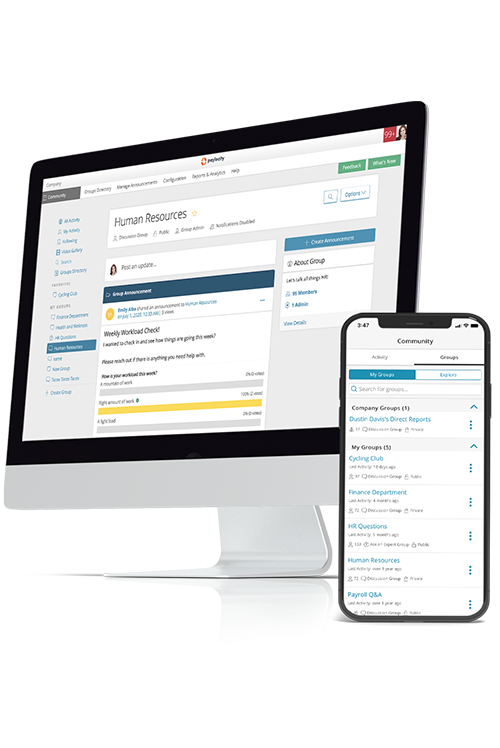Related Learning

Knock, Knock! How an Open Door Policy Can Foster a Culture of Trust and Transparency
Employees who feel heard build thriving companies. Ignored ones head for the door.
It’s not just a sentiment — it’s backed by data. Employers who regularly solicit and act on feedback are 11 times more likely to retain employees.
That’s where an open-door policy helps. It’s not just a symbolic gesture but a real commitment to listening. Engagement and trust skyrocket when leaders create an environment where employees feel safe sharing ideas, voicing concerns, and providing feedback without fear of repercussions.
In this article, we’ll discuss the importance of an open-door policy and how to start one. We will also explore the benefits and challenges to help you decide if it’s a good fit for your organization.
Key Takeaways
- An open-door policy encourages employees to approach managers or leaders with questions, concerns, ideas, or feedback.
- Key benefits of an open-door policy include finding and resolving issues effectively, building trust and transparency, cultivating genuine relationships, and motivating and engaging employees.
- To implement an effective open-door policy, it's important to clearly define it, train managers to handle sensitive conversations, and establish accessible feedback channels.
What is An Open-Door Policy?
An open-door policy is a management practice where employees are encouraged to approach upper management with questions, concerns, ideas, or feedback.
Unlike more traditional, hierarchical business structures — which can discourage employees from directly engaging with higher-ups — an open-door policy suggests that a manager's (or company's) door is always metaphorically "open" and accessible to employees.
Let’s look at some examples of what an open-door policy looks like in practice:
- "Open office hours" where employees can drop in to discuss challenges, provide feedback, or simply vent frustrations in a confidential setting. Managers are required to follow up on issues raised during these sessions.
- Regular touchpoints between employees and leadership, such as quarterly “Ask Me Anything” town hall meetings or weekly “Lunch and Learn” discussions.
- An open Q&A Slack channel or social collaboration group where employees can ask questions directly to executives
- Employees have the opportunity to submit concerns, complaints, or suggestions anonymously through digital platforms, suggestion boxes, or surveys.
What are the Pros and Cons of an Open-Door Policy?
When done right, an open-door policy encourages employees to share ideas, voice concerns, and collaborate with leadership. But, like any policy, it’s essential to understand both its benefits and drawbacks.
Here’s a closer look at what works — and what to watch out for.
Open-Door Policy Benefits
When implemented correctly, an open-door policy can:
Identify and resolve issues effectively
The transparent communication of open-door policies allows problems to be identified and addressed proactively rather than festering in the shadows.
In an HR Mixtape episode on fostering cultural transformation at work, Keystone International Group CEO Jamie Taets emphasizes that these granular conversations with employees allow organizations to “really feel like they have a pulse of what's going on [in the organization].”
Build trust and transparency
Trusting employees to voice their perspectives and knowing they will be heard and considered builds trust between employees and leadership. This trust is critical for fostering psychological safety and empowering employees to take productive risks.
Cultivate genuine relationships
About 82% of employees say they would consider quitting because of their relationship with their manager.
As John Bernatovicz, founder of Willery, says, “Pour your heart into your employees, get to know them, build relationships, understand what makes them tick.” An open-door policy is a firm step in the right direction.
Motivate and engage employees
If implemented well, an open-door policy can motivate employees psychologically through choice, connection, and competence.
With an open-door policy, organizations can accomplish all three, giving employees the autonomy to speak their minds, build relationships with leaders, and feel empowered to do the tasks at hand. Plus, when employees have the opportunity to chat with managers and get “fast feedback,” they’re nearly four times more engaged.
Best Practices for Implementing an Open Door Policy
Ready to open doors in your org? Follow these best practices for a smooth and successful transition.
Define The Policy Clearly
Documenting your open-door policy in writing creates clarity and accountability. When drafting your formal policy, be sure to include:
- The purpose. Explain why your organization embraces an open-door policy, reinforcing leadership's dedication to listening and ensuring employees feel safe from retaliation when raising concerns.
- Types of issues covered. Outline the types of concerns employees can bring forward, such as workplace challenges, process improvements, peer conflicts, or policy violations.
- Feedback mechanisms. Define how you’d like employees to voice concerns, whether through scheduled office hours, direct conversations, anonymous feedback channels, or structured meetings.
- Employee and manager expectations. Set clear guidelines for sharing and receiving feedback, fostering open, respectful, and solution-oriented discussions.
- Follow-up process. Detail how leadership will acknowledge and act on feedback, including an escalation process if issues remain unresolved.
Communicate your policy across the organization. Make it easy to access (like in an employee handbook), so every team member knows their voice matters.
Train Managers
Provide managers with training on active listening, giving constructive feedback, and handling sensitive or difficult conversations.
For example, managers should understand how to set expectations from the beginning of a conversation.
“Whenever I need to provide somebody with some type of feedback, particularly if I deem it to be constructive feedback, the first thing I always say to them is, are you open to some feedback?” said Taets, the Keystone International CEO. “And that puts the recipient of that feedback on notice because they're either going to say yes or no.”
Learn More: Feedforward vs. Feedback: A New Approach to Performance Management
Establish Accessible Communication Channels
Make it easy for any employee — remote or in-person — to request meetings.
For in-person employees, this can be done by simply offering employees the ability to walk into a manager’s office.
For hybrid and remote workers, provide digital community tools that allow employees to collaborate with leaders in real time or asynchronously and access information about the organization’s larger initiatives.

Maintain Confidentiality, Escalate When Necessary
Assure employees that their conversations and concerns will be kept confidential unless the issue requires escalation or action that necessitates involving others.
In the event of an escalation, document the steps employees can take if they feel their issue has not been adequately addressed, including options to elevate to higher levels of management.
Proactively Seek (And Act On) Feedback
If feedback hasn’t been a core part of your culture, it might be up to leadership to take the first step.
Regularly send out pulse surveys to directly solicit employee feedback. This encourages more reticent employees to offer their thoughts and reinforces that your organization is committed to listening. Over time, as trust builds, employees may be more inclined to take advantage of open-door opportunities — knowing their input truly matters.
But like any feedback initiative, follow-through is crucial. If feedback isn’t acknowledged or acted upon, it quickly becomes nothing more than lip service, eroding trust rather than building it.
Create an Open Door Policy that Works for Everyone
Adopting an open-door policy can be a huge shift for organizations accustomed to traditional hierarchies. But when implemented well, it can create a more transparent and trustworthy working environment for everyone.
Want to make an open-door policy a part of your business success? Paylocity empowers organizations to foster a culture of transparency and trust through:
- Employee Voice: Automatically collect feedback that indicates engagement and retention. Share relevant insights and create action plans to improve.
- Community: Streamline collaboration between supervisors and teammates through automatically created team groups.
- Modern Workforce Index: An HR intelligence dashboard to gain insight into employee sentiment, performance metrics, engagement, and more.
Want to learn more? Request a demo of Paylocity today!



